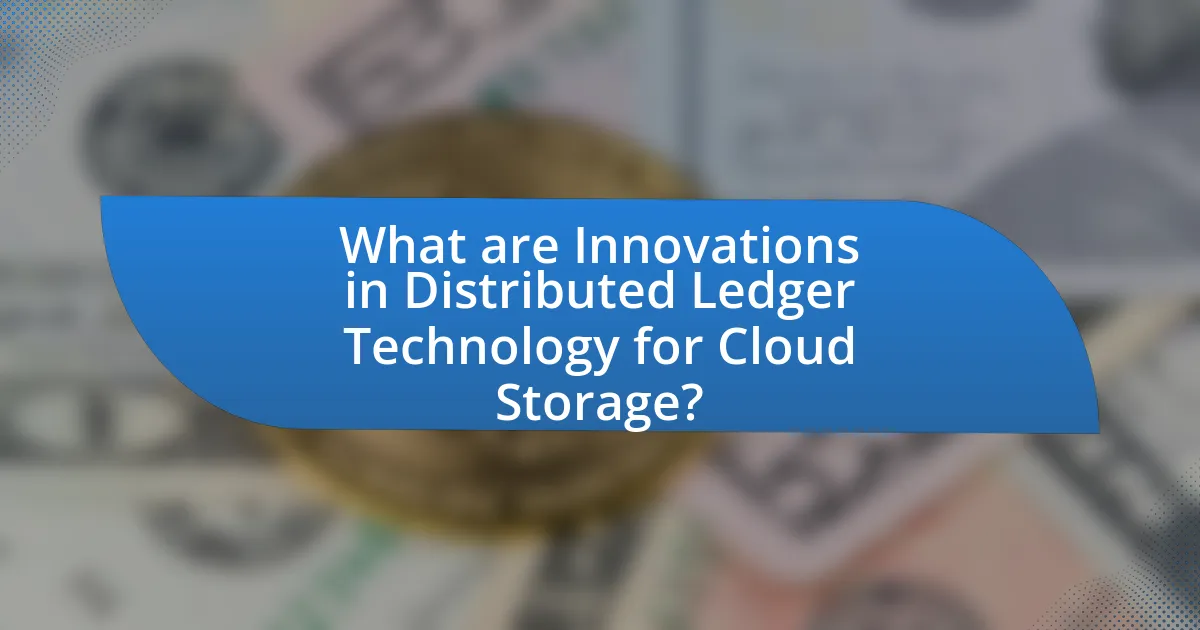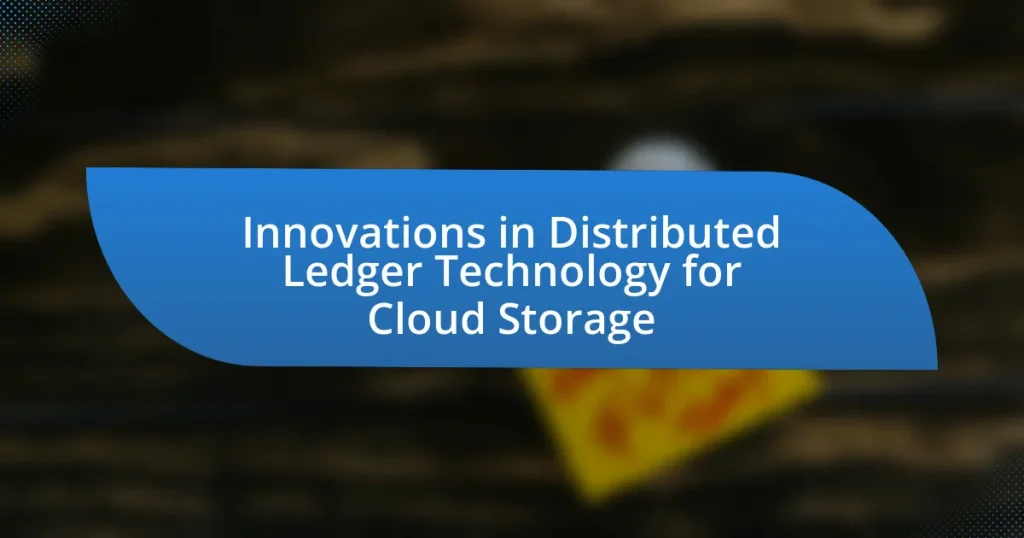Innovations in Distributed Ledger Technology (DLT) for cloud storage focus on enhancing data security, integrity, and decentralized management. Key advancements include the use of blockchain for immutable records, decentralized storage solutions like IPFS, and smart contracts for automated data management. These innovations address challenges in traditional cloud storage, such as centralized control and data breaches, while improving efficiency and reducing costs. The article also explores real-world applications, case studies, and the future prospects of DLT in cloud storage, highlighting its potential to transform data management practices across various industries.

What are Innovations in Distributed Ledger Technology for Cloud Storage?
Innovations in Distributed Ledger Technology (DLT) for cloud storage include enhanced data security, improved data integrity, and decentralized data management. These innovations leverage cryptographic techniques to ensure that data stored in the cloud is tamper-proof and accessible only to authorized users. For instance, blockchain technology enables immutable records, which means that once data is recorded, it cannot be altered without consensus from the network, thus providing a reliable audit trail. Additionally, decentralized storage solutions, such as IPFS (InterPlanetary File System), allow for distributed data storage across multiple nodes, reducing reliance on single points of failure and enhancing resilience against data loss. These advancements are supported by real-world applications, such as Filecoin, which incentivizes users to share their storage space, demonstrating the practical benefits of DLT in cloud storage environments.
How does Distributed Ledger Technology enhance cloud storage solutions?
Distributed Ledger Technology (DLT) enhances cloud storage solutions by providing improved data integrity, security, and transparency. DLT ensures that data stored in the cloud is immutable and verifiable, as each transaction is recorded across multiple nodes, making unauthorized alterations nearly impossible. For instance, blockchain, a type of DLT, allows users to track changes and access logs, which increases accountability and trust in data management. Additionally, DLT can reduce reliance on centralized servers, thereby minimizing the risk of single points of failure and enhancing overall system resilience. This decentralized approach also facilitates secure peer-to-peer data sharing, which can lead to cost savings and increased efficiency in cloud storage operations.
What are the key features of Distributed Ledger Technology in cloud storage?
The key features of Distributed Ledger Technology (DLT) in cloud storage include decentralization, enhanced security, transparency, and immutability. Decentralization allows data to be stored across multiple nodes, reducing the risk of a single point of failure and enhancing resilience against attacks. Enhanced security is achieved through cryptographic techniques that protect data integrity and confidentiality, making unauthorized access significantly more difficult. Transparency is facilitated by the ability for all participants to access the same version of the ledger, fostering trust among users. Immutability ensures that once data is recorded on the ledger, it cannot be altered or deleted, providing a reliable audit trail. These features collectively improve the efficiency and reliability of cloud storage solutions, as evidenced by various implementations in industries such as finance and supply chain management.
How does decentralization impact data security in cloud storage?
Decentralization enhances data security in cloud storage by distributing data across multiple nodes rather than storing it in a single location. This distribution reduces the risk of data breaches, as compromising one node does not grant access to the entire dataset. For instance, blockchain technology, a form of decentralized storage, employs cryptographic techniques to secure data, making unauthorized access significantly more challenging. Additionally, decentralized systems often utilize consensus mechanisms that further protect data integrity, ensuring that any changes to the data require validation from multiple parties. This multi-layered approach to security is evidenced by studies showing that decentralized storage solutions can reduce the likelihood of data loss and enhance resilience against cyberattacks.
Why are innovations in this field important for data management?
Innovations in distributed ledger technology (DLT) are crucial for data management because they enhance data integrity, security, and accessibility. DLT provides a decentralized framework that ensures data is immutable and transparent, reducing the risk of unauthorized alterations. For instance, a study by the World Economic Forum indicates that DLT can reduce data management costs by up to 30% through improved efficiency and reduced fraud. This technology also enables real-time data sharing across multiple stakeholders, facilitating better collaboration and decision-making. Therefore, the advancements in DLT directly contribute to more reliable and efficient data management practices.
What challenges in traditional cloud storage does Distributed Ledger Technology address?
Distributed Ledger Technology (DLT) addresses several challenges in traditional cloud storage, primarily focusing on data security, transparency, and data integrity. Traditional cloud storage often suffers from centralized control, which can lead to data breaches and unauthorized access; DLT mitigates this risk by decentralizing data storage across a network of nodes, making it significantly harder for malicious actors to compromise the system. Additionally, DLT enhances transparency by providing an immutable record of transactions, allowing users to verify data authenticity without relying on a central authority. This transparency is crucial for compliance with regulations such as GDPR, which mandates data traceability. Furthermore, DLT ensures data integrity through cryptographic techniques, which protect against tampering and unauthorized modifications, thereby fostering trust among users.
How do these innovations improve data integrity and availability?
Innovations in distributed ledger technology (DLT) enhance data integrity and availability by providing a decentralized and immutable framework for data storage. This framework ensures that once data is recorded, it cannot be altered or deleted without consensus from the network, thereby maintaining its integrity. For instance, blockchain technology, a form of DLT, uses cryptographic hashing to secure data blocks, making unauthorized changes easily detectable. Additionally, the decentralized nature of DLT means that data is replicated across multiple nodes, which increases availability; if one node fails, others can still provide access to the data. This redundancy is supported by studies showing that decentralized systems can achieve higher uptime and reliability compared to traditional centralized systems.

What are the latest trends in Distributed Ledger Technology for Cloud Storage?
The latest trends in Distributed Ledger Technology (DLT) for cloud storage include increased integration of blockchain for enhanced data security, the rise of decentralized storage solutions, and the implementation of smart contracts for automated data management. These trends are driven by the need for improved data integrity and transparency, as evidenced by the growing adoption of decentralized applications (dApps) that utilize DLT to provide secure and efficient storage solutions. Additionally, companies are leveraging DLT to create hybrid cloud environments that combine public and private storage, enhancing scalability and flexibility while maintaining security.
How are organizations implementing these innovations?
Organizations are implementing innovations in distributed ledger technology (DLT) for cloud storage by integrating blockchain solutions to enhance data security and transparency. For instance, companies like IBM and Microsoft are utilizing DLT to create decentralized storage systems that allow users to maintain control over their data while ensuring immutability and traceability. Additionally, organizations are adopting smart contracts to automate processes and reduce operational costs, as seen in projects like Filecoin and Storj, which leverage blockchain to incentivize decentralized data storage. These implementations are supported by the growing demand for secure and efficient data management solutions in various sectors, including finance, healthcare, and supply chain management.
What case studies highlight successful applications of Distributed Ledger Technology in cloud storage?
Successful applications of Distributed Ledger Technology (DLT) in cloud storage are exemplified by case studies such as Filecoin and Storj. Filecoin utilizes a decentralized storage network where users can rent out their unused hard drive space, creating a marketplace for data storage that is secured by blockchain technology. This model has demonstrated significant scalability and efficiency, as evidenced by its successful fundraising of over $200 million in its Initial Coin Offering (ICO) in 2017. Similarly, Storj employs DLT to provide a decentralized cloud storage solution that encrypts and distributes data across a global network, ensuring data integrity and security. The platform has reported a 90% reduction in storage costs compared to traditional cloud providers, showcasing the economic advantages of DLT in cloud storage applications.
How do partnerships between tech companies influence these innovations?
Partnerships between tech companies significantly accelerate innovations in distributed ledger technology for cloud storage by combining resources, expertise, and market reach. For instance, collaborations between established firms and startups often lead to the development of more robust and scalable solutions, as seen in the partnership between IBM and Stellar, which aims to enhance cross-border payment systems using blockchain technology. Such alliances enable the sharing of research and development costs, access to advanced technologies, and the ability to leverage each partner’s customer base, ultimately driving faster adoption and implementation of innovative solutions in the cloud storage sector.
What role do smart contracts play in cloud storage innovations?
Smart contracts facilitate automation and trust in cloud storage innovations by enabling self-executing agreements that operate on distributed ledger technology. These contracts eliminate the need for intermediaries, thereby reducing costs and increasing efficiency in data management and transactions. For instance, smart contracts can automatically enforce data access permissions, ensuring that only authorized users can retrieve or modify stored information, which enhances security and compliance. Additionally, they can streamline billing processes by automatically calculating and processing payments based on usage metrics, as demonstrated in projects like Filecoin, where smart contracts govern storage agreements and transactions.
How do smart contracts automate processes in cloud storage systems?
Smart contracts automate processes in cloud storage systems by executing predefined agreements automatically when specific conditions are met. This automation reduces the need for intermediaries, streamlining operations such as data access, storage allocation, and payment processing. For instance, when a user uploads data, a smart contract can automatically verify the transaction, allocate storage space, and initiate payment, all without human intervention. This efficiency is supported by blockchain technology, which ensures transparency and security, as all transactions are recorded and immutable.
What are the benefits of using smart contracts in data transactions?
Smart contracts enhance data transactions by automating processes, ensuring transparency, and reducing costs. They execute predefined agreements without intermediaries, which minimizes the risk of human error and fraud. For instance, a study by the World Economic Forum indicates that smart contracts can reduce transaction costs by up to 30% by eliminating the need for third-party verification. Additionally, the immutable nature of blockchain technology ensures that once a smart contract is deployed, it cannot be altered, providing a secure and trustworthy environment for data transactions.

What are the future prospects of Distributed Ledger Technology in Cloud Storage?
The future prospects of Distributed Ledger Technology (DLT) in cloud storage are promising, as DLT can enhance data security, transparency, and integrity. By decentralizing data storage, DLT reduces the risk of data breaches and unauthorized access, which is critical given that data breaches affected over 36 billion records in 2020 alone. Furthermore, DLT enables immutable records, ensuring that data cannot be altered without consensus, which is vital for compliance with regulations such as GDPR. As organizations increasingly prioritize data sovereignty and privacy, the integration of DLT in cloud storage solutions is expected to grow, with market projections estimating the global DLT market to reach $69.04 billion by 2027, reflecting a compound annual growth rate of 56.1% from 2020.
How might emerging technologies influence Distributed Ledger Technology?
Emerging technologies such as artificial intelligence, quantum computing, and the Internet of Things (IoT) are likely to significantly influence Distributed Ledger Technology (DLT) by enhancing its efficiency, security, and scalability. For instance, artificial intelligence can optimize consensus algorithms, making transaction verification faster and reducing energy consumption. Quantum computing poses both a threat and an opportunity; while it could potentially break existing cryptographic methods used in DLT, it also offers new cryptographic techniques that could strengthen security. Additionally, the integration of IoT with DLT can facilitate real-time data sharing and automated transactions, thereby increasing the utility of DLT in various applications. These influences are supported by ongoing research and development in these fields, indicating a trend towards more robust and versatile DLT systems.
What potential advancements could enhance cloud storage security?
Potential advancements that could enhance cloud storage security include the integration of distributed ledger technology (DLT), which provides immutable data records and decentralized control. DLT can significantly reduce the risk of data tampering and unauthorized access by ensuring that all transactions are transparently recorded across multiple nodes, making it nearly impossible for a single entity to alter the data without consensus. For instance, blockchain technology, a type of DLT, has been shown to improve data integrity and security in various applications, as evidenced by its use in sectors like finance and healthcare, where data breaches can have severe consequences. Additionally, advancements in encryption techniques, such as homomorphic encryption, allow data to be processed in an encrypted state, further protecting sensitive information while maintaining usability. These innovations collectively contribute to a more secure cloud storage environment by enhancing data protection and access control mechanisms.
How could regulatory changes impact the adoption of these technologies?
Regulatory changes could significantly impact the adoption of distributed ledger technologies (DLT) for cloud storage by either facilitating or hindering their implementation. For instance, favorable regulations that promote data privacy and security can encourage organizations to adopt DLT, as these technologies inherently provide enhanced security features and transparency. Conversely, stringent regulations that impose heavy compliance burdens may deter companies from integrating DLT into their cloud storage solutions, as seen in the European Union’s General Data Protection Regulation (GDPR), which has influenced how businesses approach data management and storage technologies. Thus, the nature of regulatory frameworks directly shapes the willingness and ability of organizations to embrace innovations in DLT for cloud storage.
What best practices should organizations follow when adopting Distributed Ledger Technology for cloud storage?
Organizations should prioritize security, scalability, and interoperability when adopting Distributed Ledger Technology (DLT) for cloud storage. Ensuring robust encryption and access controls protects sensitive data from unauthorized access, while scalability allows the system to handle increased loads as data grows. Interoperability with existing systems and other blockchains enhances functionality and user experience.
For instance, a study by Deloitte highlights that 39% of organizations consider security as the primary concern when implementing DLT, emphasizing the need for comprehensive security measures. Additionally, successful DLT implementations often utilize modular architectures to facilitate scalability and integration, as seen in projects like Hyperledger Fabric, which supports various consensus mechanisms and can be tailored to specific organizational needs.
How can organizations ensure compliance with data protection regulations?
Organizations can ensure compliance with data protection regulations by implementing robust data governance frameworks that include regular audits, employee training, and the use of encryption technologies. These frameworks help organizations identify and mitigate risks associated with data handling and processing. For instance, the General Data Protection Regulation (GDPR) mandates that organizations conduct Data Protection Impact Assessments (DPIAs) to evaluate risks and ensure that data processing activities comply with legal requirements. Additionally, employing distributed ledger technology can enhance data integrity and security, making it easier to track data access and modifications, thereby supporting compliance efforts.
What strategies can enhance user trust in Distributed Ledger Technology solutions?
To enhance user trust in Distributed Ledger Technology (DLT) solutions, implementing transparency, security measures, and user education is essential. Transparency can be achieved through open-source protocols, allowing users to verify the code and operations of the DLT. Security measures, such as robust encryption and regular audits, protect user data and build confidence in the system’s integrity. User education initiatives, including workshops and informative resources, empower users to understand DLT functionalities and benefits, fostering a sense of control and trust. Research indicates that organizations employing these strategies see increased user adoption and satisfaction, as evidenced by a 2021 study from the World Economic Forum, which highlighted that transparency and security are critical factors influencing user trust in blockchain technologies.


